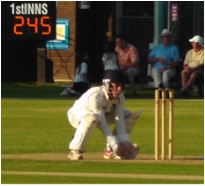Leo Camish
Radiofrequency Chondroplasty to patella
I am a 15-year-old student at Hurstpierpoint College, Sussex, where I play a term of Rugby, a term of Hockey and a term of Cricket. I also represent Sussex at Cricket, where I have played for the last 3 years as a wicket keeper / batsman.
I developed a pain in my right knee early in January 2012 as our Hockey term started, and this became progressively worse each game I played. In early February, I stopped playing Hockey and sought advice from Mr McDermott and his colleagues, in London Sports Orthopaedics. I had an MRI scan at a local facility a few miles from my home near Sevenoaks followed by consultations in Northwood.
I ended up having arthoscopic surgery on 4th April 2012, to remove a medial plica and to tidy up some articular cartilage damage on the back of my kneecap. Having had a general anaesthetic, I was able to see the full procedure on the DVD that Mr McDermott recorded for me, and could see the cause of my original pain: rough areas of damaged cartilage that was beginning to come away from the joint surface. These were trimmed and made smooth again with a tiny probe.
Leo had a medial plica in his knee, which was trimmed, but his main problem was quite nasty partial thickness damage to the articular cartilage on the back of his kneecap. This was smoothed off and stabilised by radiofrequency chondroplasty. This relies on a tiny probe made by Arthrocare, where an electric current at the tip of the probe creates a sodium plasma field from the sodium ions in the salt water that is pumped through the knee during the arthroscopy. This plasma melts the rough, unstable, damaged surface of the articular cartilage, smoothing it off and stabilising it but without causing any thermal damage to the underlying tissue layers and the cells in the cartilage beneath. Radiofrequency chondroplasty using low-temperature ‘coblation’ probes from Arthrocare has been shown to stabilise damaged articular cartilage – reducing pain, increasing function and protecting the joint surface. It has been shown to be significantly superior to other arthroscopic techniques for treating partial thickness cartilage damage, such as ‘abrasion chondroplasty’ with shavers. Sadly (perhaps criminally!), only a minority of knee surgeons actually seem to be using this new technology on any kind of regular basis – some of those not using it have given excuses such as ‘it slows me down’! and some simply don’t know of or don’t understand the relevant research. For me, if a radiofrequency probe were not available in theatre, then I would simply cancel the case and reschedule it rather than going ahead and knowingly do a second-class job! (Thankfully, I only work in excellent hospitals, where this has never had to be the case!)
I was worried that the injury would badly disrupt the most important part of the year for me as a cricketer… the summer season, which starts at the end of April. I ended up missing just 1 game and was back playing for Sussex U15 by mid-May, only 44 days after my surgery. After a very wet June, I have played a lot of cricket and have not felt any pain at all. I will also be representing Sussex Academy on their three-week tour to Cape Town this December … a trip that would not have been possible six months ago. I am really happy to have had the surgery and recovered quickly. I must thank Mr McDermott for his care and skill to get me back on my feet playing the sport that I love!
Leo Cammish
2012
March 2017

